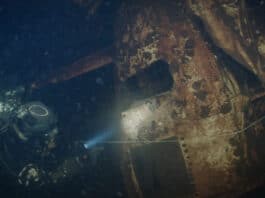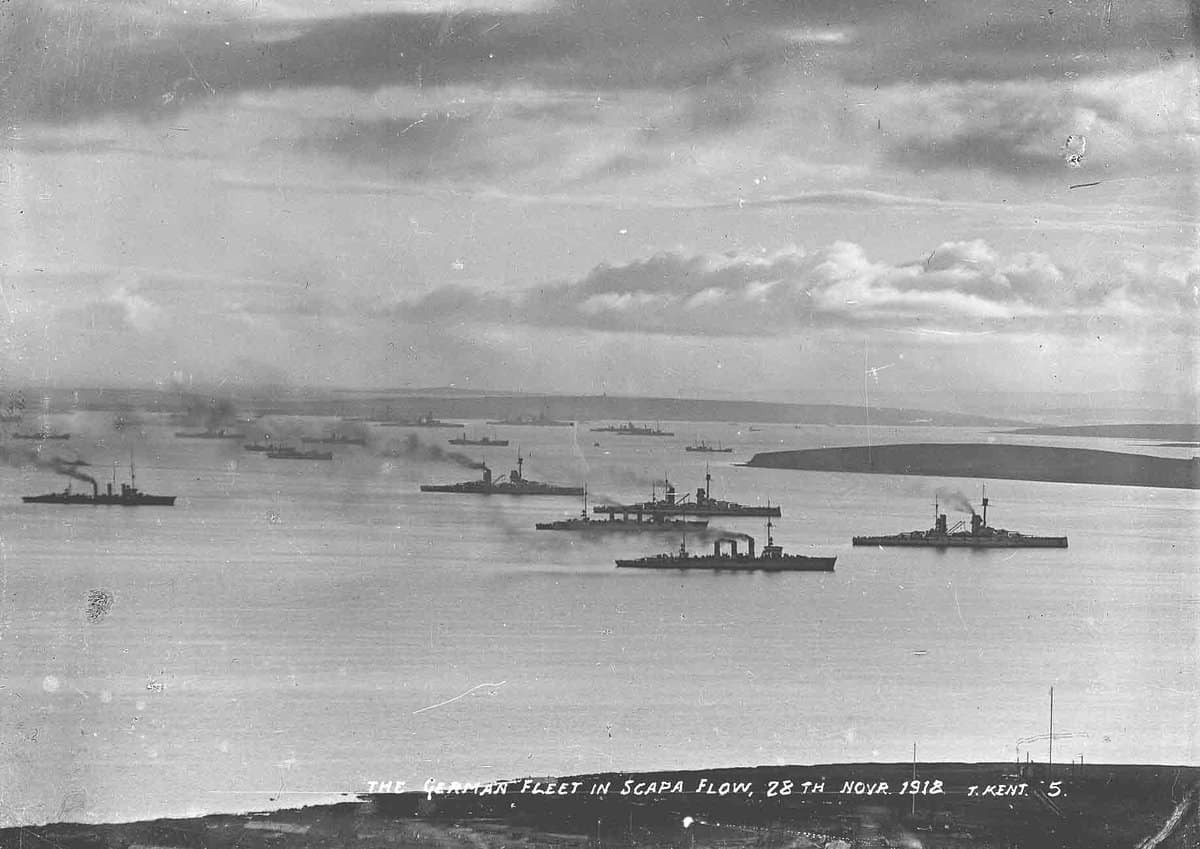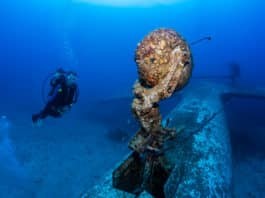By Dan Leigh, DAN Communications
From the March 2002 issue of Alert Diver
"… In the Straits of Mackinac, the Cedarville requires two distinct dives because it is 588 feet long (179 meters). Tipped over on its starboard side, it lies in 105 feet of water (32 meters), but the superstructure and cabins are only about 50-80 feet down (15-24 meters). The pilothouse is usually the preferred first dive. There is a buoy on each end. Either dive can be dangerous, given the currents of the Straits and the loose gear and numerous portals to explore. On cloudy days it is very difficult to navigate such a large wreck.
"In the topsy-turvy world of the Cedarville wreck, it is very easy to get disoriented. This makes penetration diving dangerous because the logical way out is often blocked by bulkheads, decks, gear and ceilings. A safety ‘tag line’ and a buddy are a must
Without a reel or much advanced training, two divers penetrated a wreck. While their planning was faulty, the rescue performed by others was not.
In the summer of 2000, in the Straits of Mackinac, where Lakes Huron and Michigan meet, a routine wreck dive became everything but ordinary for two divers who were nearly trapped inside a wreck, and for a handful of skilled divers who constituted an impromptu rescue team. The story ended well. The two survived, and all had a rescue story to tell.
On this particular Sunday, four dive boats tied up at the wreck of the Cedarville, a 588-foot / 179-meter steel freighter sitting on its starboard side in 105 fsw / 32 msw. Multiple mooring lines at the wreck allow many boats to tie up at one time.
Cave diver Dave Mekker, a DAN Member from Stoney Creek, Ontario, joined others on the Sand Dollar. He recalled the weather did not show great promise for diving that day: overcast, with rain, high winds and thunderstorms in the forecast. After some discussion at the dock and a quick run out to the wreck, Mekker said, it was decided to load gear for diving.
Said Mekker: "When we got to the wreck site, our two boats (Sand Dollar and Virtual Reality, both chartered by the Niagara Divers Association) were moored to the ship’s bow, while two other boats, Straits Rec Diver and Intrepid, were moored to the ship’s stern. The rainy weather earlier that day caused poor visibility on the wreck, but we all managed to get in a dive."
Varying visibility – about 15-20 feet / 4.5-6 meters at depth and 30-40 feet / 9-12 meters at the top of the wreck – set the stage for the dives. With lights but no reel, two divers from the Intrepid entered the shipwreck’s engine room, then became lost and disoriented in the silted passageways and compartments. They found a porthole and began waving to attract the attention of other divers. They banged on the steel hull with their lights, but to no avail.
The smaller diver, himself a divemaster, removed his gear, pushed his tank, buoyancy compensation device (BCD) and regulator through the porthole, and slid out the opening and up to the surface. Once topside, he shouted, "My buddy is trapped in the wreck."
Getting Help
About 200 feet / 60 meters away, as crew members aboard the Intrepid busied themselves helping divers aboard the boat following their first dive, Capt. Mark Kistner of Warren, Mich., saw the diver bob to the surface. "I knew the divers had been in the water about 35 minutes and that air supply was a primary issue," Kistner said.
Kistner, a DAN Member since 1995, grabbed a 40-cubic-foot air tank and his torpedo (a dive propulsion device). Without hesitation and without thermal gear, he sped to the wreck to find the diver.
"I was happy to have the torpedo that day; it helped me travel fast to the wreck, getting to the distressed diver quicker," he said. "Initially, when I saw the diver, his head and one arm were sticking out a porthole; he gave me the out-of-air signal." Through the porthole, Kistner shared air from the pony bottle with the diver.
Meanwhile, at the surface, Virtual Reality Capt. Andy Donato, a DAN Member from Marysville, Mich., and divers on board waited for the boat’s last two divers to surface. Nearby, the Sand Dollar crew had untied the boat’s line and planned to move to the midship mooring for a second dive.
When the diver popped to the surface, waving his hands and calling for help, Sand Dollar Capt. Jim Stayer, a DAN Member from Lexington, Mich., radioed the other boats that there was an emergency. Stayer said he saw the urgency of the situation, adding: "I took charge." He spun the Sand Dollar around to pick up the diver. Once aboard, the diver told Stayer that his buddy was stuck in one of the wreck’s forward passageways.
Devising A Rescue Plan
Mekker said that, by this time, Sand Dollar divers led by Stayer had begun developing a plan. It was decided that, after a surface interval of only 17 minutes, cave divers Mekker and Anthony DeBoer of Richmond Hills, Ontario, would gear up and penetrate the wreck, carrying an 80-cubic-foot tank to the trapped diver. At about the same time, Mike Apple and Steve Orht, advanced divers from Columbus, Ohio, had completed their dives and were returning to Virtual Reality. They would remain in the water to assist in the rescue.
Meanwhile, Donato had prepared an 80-cubic-foot tank with a regulator, and Apple conveyed it to the trapped diver and relieved Kistner, who had been sharing air with the diver through the porthole opening.
Apple, a DAN Member who is also a police diver, recalled that he had to reach through the porthole to keep the diver from sinking or going back into the wreck. "He took maybe 10 hard breaths from my air supply," Apple said. "I calmed him down, indicating that things were OK."
Donato described Apple’s special skills: "Mike Apple is a uniquely trained individual, extremely strong. He was a college swimmer, and did or does covert government missions. I knew this of him, and it was timely that he showed up on my swim platform when he did…"
Soon after Mekker and DeBoer descended, Donato pulled Virtual Reality alongside the Sand Dollar to transfer an oxygen bottle for a drop system that Stayer was rigging up with his own supply of oxygen. The captains feared that the five divers would be racking up a lot of decompression time, so the drop system at 13-15 feet / 3.9-4.5 meters depth would provide six regulators for the divers to complete accelerated decompression on pure oxygen. The diver trapped in the wreck actually recorded more than one hour and 10 minutes of bottom time.
Entering the Wreck
DeBoer had not planned to enter the wreck that day due to overcast weather; he had left his equipment in his car. For the wreck penetration, he used a borrowed backup light and reel. When the two entered the Cedarville, they first verified the diver’s position and that he had air; they then proceeded to find a way to reach him.
Said Donato: "Because of the wreck’s semi-inverted position, they had to descend to about 100 fsw (30 msw) until they found an opening into the engine room. They worked their way through an area they had never been before in almost zero visibility, and ascended until they saw portholes and eventually found the diver at a depth of about 60 fsw (18 msw)."
Mekker led the diver by the hand along the line, with DeBoer reeling in the line behind until they cleared the wreck and went up to the mooring and descent lines. Mekker and DeBoer surfaced with the news that the second diver was safe, decompressing on the line with Apple. Aboard the Sand Dollar, the diver who had surfaced on his own had begun using oxygen, which was administered by Maria Bellantino, a DAN Member from Welland, Ontario. He drained the oxygen cylinder and showed no symptoms of decompression sickness.
Steve Orht, acting as liaison between the divers and those aboard the boats, went down the line with a slate to let the two divers – Apple and the rescued diver – know there was oxygen available off the boat, via a drop system. Realizing that the divers could not locate the oxygen without help, Mekker and DeBoer descended again, tied off a reel to the oxygen and regulators and directed the divers to the oxygen. Shortly thereafter, all the divers surfaced, safe and sound.
Added Donato, who had helped forge the plan and had monitored goings-on: "Both Sand Dollar and Virtual Reality had large oxygen cylinders with in-water hang systems to speed along decompression. Both systems were put to use … The trapped diver had a decompression penalty to burn off due to his excessive bottom time. This was noted on his dive computer. The other divers may have also required some decompression time since this was their second dive, albeit an unplanned one. We had them all on oxygen at their 10-foot (3-meter) stop."
Calling DAN
Later during the incident, DAN was called to consult about managing the diver who had surfaced on his own. On board and exhausted, he had been given oxygen. Dan Nord, DAN Medical Services Director, received the call and asked about symptoms. When told there were none, Nord recommended that the diver undergo a careful medical evaluation, preferably by a physician trained in diving or hyperbaric medicine. He also expressed some concern, given the absence of symptoms, that the administration of oxygen may have been premature.
"When someone without symptoms receives oxygen, it may effectively delay symptom onset, and perhaps delay treatment," Nord said. "Delays to treatment may complicate the management of DCS and make it more difficult to treat. The introduction of 100% oxygen initiates a course of treatment, which should be followed up with a careful medical evaluation to rule-out the presence of subtle signs or symptoms. As it turned out, the diver called the DAN Diving Emergency Hotline later that day, relating new symptoms of possible DCS. I referred him to evaluation, where he was later treated in a hyperbaric chamber. He had sustained a mild hit."
The events of this dive and rescue unfolded in less than 30 minutes. Said Mekker: "Next year, we need to go back so we can explore the stern section of the Cedarville under different conditions."
Onboard the Cedarville
The Cedarville is two distinct dives because it is 588 feet long. It lies tipped over on its starboard side. The pilothouse is recommened for the first dive. There is a buoy on each end. Either dive can be dangerous because of the currents of the Straits and the loose gear and numerous portals to explore. It lies in 105 feet of water but the superstructure and cabins are only about 50 to 80 feet down.
The Wreck Of The Cedarville
The wreck of the freighter Cedarville is found near Mackinac City, Mich., about 3.5 miles / 5.6 km from the Mackinac Bridge. The freighter was built in River Rouge, Mich., in 1927.
On May 7, 1965, with a crew of 35 and a cargo of limestone, the Cedarville set off from Calcite, Mich. to Gary, Ind. A thick fog shrouded the approach to the Mackinac Bridge. The captain could see another ship on radar but could not make radio contact. He tried evasive actions, which proved unsuccessful. The other ship, Topdalsfijord, rammed the port side of the Cedarville. The captain headed for shallow water but did not make it; the ship sank, and 10 sailors lost their lives.


